Sylvie Girard-Lagorce: "The great wines of the world".
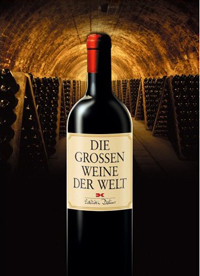 Now is the time for reading weekends - and with them the opportunity to enjoy books that could pass for classic "coffee-table" or "wine-table" books: Mostly many photographs, representative texts, large format, heavy paper - but also always of heavy content?
Now is the time for reading weekends - and with them the opportunity to enjoy books that could pass for classic "coffee-table" or "wine-table" books: Mostly many photographs, representative texts, large format, heavy paper - but also always of heavy content?
Sylvie Girard-Lagorce's "The Great Wines of the World", for example, does indeed present itself as an - as the blurb promises - opulent "invitation to enjoy", as a colourful, richly illustrated, very restrainedly texted journey to the best, or at least to many of the best wine-growing regions in the world.
France and Germany form the prelude, followed by Switzerland and Austria. Italy, Spain and Portugal are other European focal points. New World countries such as Chile and Argentina, Australia and New Zealand are covered under "Other Continents".
And how could it be otherwise, of course France forms its own continent of wine quality here; what follows it can at best still be "dealt with": On just under 200 pages, the wine country of France - beginning with Alsace and ending with the Rhone Valley - is presented in an almost encyclopaedic manner.
Germany is still represented with short summary texts on "Mosel-Saar-Ruwer" and "Rhine"; 19 top estates, from Bassermann-Jordan to Forstmeister Geltz Zilliken, are presented very briefly, with a short introduction and information on the growing area, cultivation area and location, grape varieties, number of bottles per year and the best vintages. Unfortunately, little details such as the internet address or the VDP affiliation (which is not always visible on the neck of the bottle) are omitted.
The conception of the comparatively inexpensive book - its introduction borne by a passion for wine, the refraining from the impositions of the modern wine world as well as the consistent visualisation of what is precisely not in the cellar as a bottle - is ultimately a contribution to the mystification of a cultural asset that is probably being exaggerated a little too much here.
In the end, the quality of the wine is even relieved of the adversities of time, rain and sun: "Beyond taste, prestige and fame, there still exists a criterion that proves superior in the choice of the best wines of the world: quality balanced from vintage to vintage" If this was really the "superior criterion" - would there still be the phenomenon of the "best vintages"?
The great wines of the world<IMGstyle="BORDER-RIGHT: medium none; BORDER-TOP: medium none; MARGIN: 0px; BORDER-LEFT: medium none; BORDER-BOTTOM: medium none" height=1 alt="" src="http://www.assoc-amazon.de/e/ir?t=200434&l=as2&o=3&a=3768818055" width=1 border=0Sylvie Girard-Lagorce: "The Great Wines of the World".
384 pages, 124 colour photos, 620 illustrated wine bottles
Delius Klasing Verlag"
Edition Delius", BielefeldISBN
3-7688-1805-519
,90
Michel Bettane / Thierry Desseauve: "Great Wines of the World"
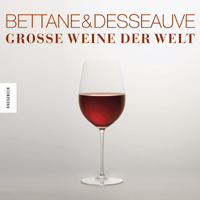 book by the renowned French wine journalists Michel Bettane and Thierry Desseauve
book by the renowned French wine journalists Michel Bettane and Thierry Desseauve
 Great Wines of the World" is also a feast for the eyes
Great Wines of the World" is also a feast for the eyes
Here, too, the factual section - without mentioning the web address - is kept to the minimum with the indication of grape varieties and areas and the reproduction of a representative label. But those who have made themselves comfortable with the bibliophile declaration of love for wine, which weighs exactly 3 kilograms, can enjoy an extremely attractive combination of pictures and text.
The 485 photo-illustrations not only evoke the myths of great wineries and their great wines. They also show not only the special features of the various wine-growing regions - for example, the steep slopes on the Rhine, Moselle and Saar; the characteristically wide landscapes in South Africa, Australia and the USA; or vineyards in the play of natural forces: in glaring sunshine, in autumnal banks of mist, covered by ice and snow.
The picture section also contains unconventional portraits of winegrowers (also of lesser-known ones than Coppola and Mondavi, who are represented here), of winery workers pruning the vines, at the shaking table or in the barrel removing the tartar, which is hardly less "romantic". The photographs also document - often in very atmospheric, double-page shots - the hard work involved in planting new vineyards or cultivating them with horses, and do not conceal how landscapes are altered or even newly created by wine production on an industrial scale.
The texts complement the pictures congenially: Bettane and Dessauve succeed in describing the geographic, climatic and also the technical-personal prerequisites of the respective wine cultures and wine styles in the portraits of 365 wineries and winegrowers, which are also attractively set in the type design, in a way that is both concise and informative.
The respective paragraphs "Our favourite wines" add a refreshingly subjective note to the appreciation of the wines, which, according to Bettane and Dessauve, always tell "one and the same story":
While Sylvie Girard-Lagorce, in the briefest possible description of the individual estates, does not elaborate on their wine qualities and respective self-image, Bettane and Dessauve describe and justify them in such a comprehensible way that the reader will probably
want to try them out.The fact that this might be possible at least occasionally is due to an essential selection criterion of the two authors: "In a book for a broad audience of lovers of good wines" it seemed to them "necessary to give preference to reality over myth". Even though we have the highest admiration for some Microcrus, we have eliminated such tiny producers whose distribution is too limited for anyone to find a bottle of this wine in a cellar.
"Great Wines of the World at AmazonMichel Bettane / Thierry Desseauve: Great Wines of the World
Knesebeck Verlag; 600 pagesISBN
3-89660-378-749
,95
Rolf Rosche
Auf der sächsischen Weinstraße (On the Saxon Wine Route
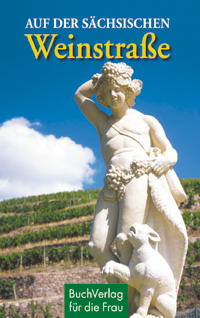 A coffee-table book of a completely different kind - a wine-saxon vade mecum; a small travel guide ready to hand at any time for the smaller ladies' handbag, trouser or Sacco inside pocket; a bibliophile gift for many occasions, especially along the Elbe - has been published by
A coffee-table book of a completely different kind - a wine-saxon vade mecum; a small travel guide ready to hand at any time for the smaller ladies' handbag, trouser or Sacco inside pocket; a bibliophile gift for many occasions, especially along the Elbe - has been published by
 BuchVerlag für die Frau" (that is its real name)
BuchVerlag für die Frau" (that is its real name)
The informative compilation of historical information about winegrowing, the vineyards of Dresden and some selected estates - though without addresses - does not answer the question why the books from "BuchVerlag für die Frau" have to be so small (6.2 x 9.5 cm): Is it because the wine-growing region of Saxony is the smallest of all wine-growing regions?
Auf der sächsischen Weinstraße bei AmazonRolf Rosche: Auf der sächsischen Weinstraße
BuchVerlag für die Frau, Leipzig, 128 pagesISBN
3-89798-176-95
,--
Bordeaux Total"
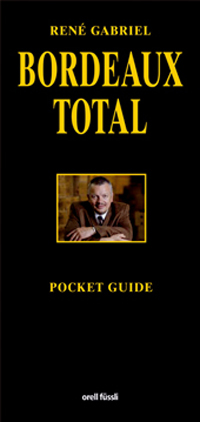 not necessary to read the 717-page book
not necessary to read the 717-page book
 Bordeaux Total", which is as heavy as it is informative, to be convinced of the Swiss wine journalist's Bordeaux expertise
Bordeaux Total", which is as heavy as it is informative, to be convinced of the Swiss wine journalist's Bordeaux expertise
 A closer acquaintance with the paperback edition ("Pocket Guide"), now published for the first time, is enough.
A closer acquaintance with the paperback edition ("Pocket Guide"), now published for the first time, is enough.
Already the assessment of the Bordeaux classification of 1855 and the subsequent classifications in the other appellations is refreshingly clearly formulated:
"Nowhere in the world is the classification salad as diffuse as in Bordeaux."
Againstthe background of huge leaps in quality in recent decades due to
"selection, technology, new barriques and multicultural oenologists", Gabriel has developed an independent, well-founded
"Bordeaux classification" against this
"salad"
.Whoever wants to be included in this classification, from the Cinquième Crus classés to the Premiers Grand Crus classés and the Crus Bourgeois, should not land a one-off big hit, but convince with high-quality continuous work over ten years. Otherwise, it could still be enough to be counted among the "expensive aspirants" or the "new mega-values".
Afterwards, more than 400 Chateaux are presented in a concise and trenchant manner with information on "maturity for enjoyment" and point ratings for the individual vintages. Even if many of the wines discussed will remain inaccessible to those interested in Bordeaux, they will gain access to the book and to Bordeaux through Gabriel's language, which is often fierce, occasionally coarse, but in any case always entertaining: instead of a dry treatise, one can read, for example, that he has "never tasted a really good wine..." at a chateau; instead of a dry treatise, one can read that he has "never tasted a really good wine...". has never tasted a really good wine"; at another, he advises against it altogether, because "if you love Bordeaux, you should keep your hands off it"; sometimes "the vintages between 1966 and 1982 resemble a weeping willow", at another chateau "you're never sure whether it's wine, St. Emilion or bluff".
Far from blinded Bordeaux worship and unabashedly unashamed of established names, Gabriel, fortunately for the reader, has no problem heartily criticising "an oenological, thick wine cream with more jam and barrique flavours than wine aromas" or a "phantom wine with no clear definition, made to dazzle journalists". Finally, a quote against the mere insistence on tradition:
"The only thing modern about this wine is its website.
"Bordeaux Total - Pocket Guide at AmazonRené Gabriel: Bordeaux Total - Pocket Guide
Orell-Füssli, 288 pagesISBN
3-280-05194-0
23Specialist
and textbooksHorst
Dietrich Mohr (ed.):
Farbatlas Krankheiten, Schädlinge und Nützlinge" (Colour Atlas of Diseases, Pests and Beneficial Organis
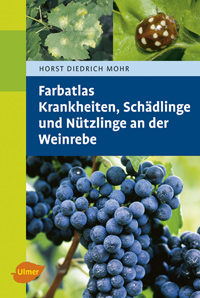 Whether an industrial product or a product of art and culture: The underlying natural product, the vine, the grape and the vine, are highly susceptible to "diseases, pests and beneficial insects", which are described in the colour atlas of the same name by the Ulmer Verlag for "winegrowers, advisors, students, technical students and all those interested in viticulture" in a way that is indeed as exciting as it is informative.
Whether an industrial product or a product of art and culture: The underlying natural product, the vine, the grape and the vine, are highly susceptible to "diseases, pests and beneficial insects", which are described in the colour atlas of the same name by the Ulmer Verlag for "winegrowers, advisors, students, technical students and all those interested in viticulture" in a way that is indeed as exciting as it is informative.
The "conflicts" in nature and with nature that influence the grapes and ultimately also the wine quality are recognised and must be eliminated, and are described in a well-founded manner by a team of authors with proven expertise in the field: The diseases and pests (the "beneficial organisms" are also dealt with extensively) are treated schematically in pleasantly objective diction - without clichés and unpathetic - according to the respective damage pattern, possibilities of confusion, biological-physiological appearance and treatment or prevention.
The handy atlas should not only serve experts as a vade mecum for seasonal walks along vineyards:
It also enables other wine enthusiasts to recognise damage, explains in a concentrated way the plant protection practice in ecological viticulture ("The aim is to achieve self-regulation of the vineyard ecosystem"), clarifies the sensory consequences of diseases such as vinegar rot (vinegar odour) and ultimately illustrates the great difficulties and challenges facing quality-oriented viticulture in particular: The basis of the cultural product wine - the vine - is a sensitive microsystem in the vineyard ecosystem.
Horst Dietrich Mohr (ed.): Farbatlas Krankheiten, Schädlinge und Nützlinge an der Weinrebe320
pages, 250 colour photos and graphicsISBN
3-8001-4148-519
,90
Helmut Hans Dittrich:
"Mikrobiologie des Weines" (Microbiology
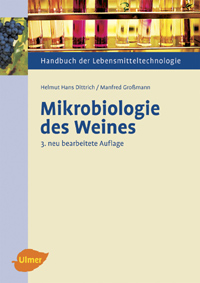 For
For
 students, scientists and practitioners of the wine industry, biotechnology, viticulture and oenology", the volume "Mikrobiologie des Weines" (Microbiology of Wine) published by the same publishing house in the series "Handbuch der Lebensmitteltechnologie" (Handbook of Food Technology) offers a much more sophisticated in-depth reading of what is still "generally comprehensible" in the colour
students, scientists and practitioners of the wine industry, biotechnology, viticulture and oenology", the volume "Mikrobiologie des Weines" (Microbiology of Wine) published by the same publishing house in the series "Handbuch der Lebensmitteltechnologie" (Handbook of Food Technology) offers a much more sophisticated in-depth reading of what is still "generally comprehensible" in the colour
The current state of knowledge and research on all essential microbiological and chemical processes relevant to winemaking is presented here in an overview. However, the didactically successful preparation makes the book valuable not only for scientists and practitioners. Even "laymen" interested in wine, who have neither studied oenology nor completed an apprenticeship in winemaking, will find individual chapters of interest: The sections, for example, on the influence of different temperatures on fermentation ("the most important influencing factor for wine production"!), pure yeast fermentation and spontaneous fermentation ("normality over thousands of years") or different processes for sherry production ("targeted influence of oxygen") are exciting and instructive precisely in their sober objectivity.
The remarks in the preface are to be unreservedly agreed with: "There are many books about wine, but none contemporary about the living beings that make wine in the true sense of the word'...Without the microorganisms discussed here, there would be no wine. It is they who prepare the delicious drink
..."Mikrobiologie des Weines bei AmazonHelmut Hans Dittrich unter Mitarbeit von Manfred Grossmann: Mikrobiologie des Weines
Ulmer 2005, 240 SeitenISBN
3-8001-4470-059
,90
Günter Schruft (Ed.):
Deutsches Weinbau Jahrbuch 2007"
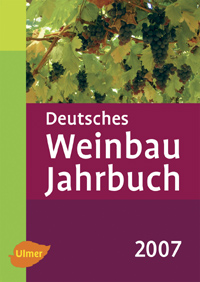 No less sober and unpretentious in book design, typesetting and photo quality is
No less sober and unpretentious in book design, typesetting and photo quality is
 Deutsche Weinbau Jahrbuch 2007", now in its 58th
Deutsche Weinbau Jahrbuch 2007", now in its 58th
For a very reasonable price, the reader interested in scientific papers receives a yearbook whose purchase is worthwhile for the appendix alone: this is dryly called "Statistics, Tables and Directories" and contains the figures for viticulture in the world (with areas, export, import and consumption figures) and viticulture in Germany as well as the almost encyclopaedic listing of all relevant German-language wine associations and wine organisations.
The 28 specialist articles cover a broad spectrum of interests appealing to professionals and amateurs alike: Very specific questions such as "Scott-Henry - An alternative to trellising?" or "New method for early detection of fermentation disorders" are covered just as thoroughly as generally significant topics such as "Globalisation of the wine industry: Does German wine still have a chance?".
Deutsches Weinbau-Jahrbuch 2007 bei AmazonGünter Schruft (ed.): Deutsches Weinbau Jahrbuch 2007
Ulmer / Stuttgart; 260 SeitenISBN
3-8001-5325-49
,90
Wine calendars:
 For some years now, the swelling flood of wine books has been joined by the increasingly popular wine calendars, which very successfully focus on the photogenic communication of wine clichés, but also the touching reminder of wine culture and the quality of life shaped
For some years now, the swelling flood of wine books has been joined by the increasingly popular wine calendars, which very successfully focus on the photogenic communication of wine clichés, but also the touching reminder of wine culture and the quality of life shaped
How much the world of wine lives on images and from images, how much it presents itself - far away from large-scale wine industrial production - as an inexhaustible source of inspiration and vinophilic fantasy production with shining grapes, traditional wineries, picturesque vineyards and timeless wine villages, is shown, for example, in the wall calendar "Wine 2007" by the ars vivendi publishing house. The impressions, for example, of St. Emilion, the vineyards near Heppenheim, but also of a still life with bread and wine inspire wanderlust and longing - and testify to the suggestive power of wine and its stimulating forces in the glass, in the landscapes and in cultural history.
 The photographs for a calendar that is almost expansive in motifs and dimensions, also published by ars vivendi, were taken by photographer Hendrik Holler, who specialises in the subjects of food & drink, but especially wine: "The World of Wine 2007" shows famous wine locations - whether Napa Valley during the mustard blossom or Haute Cabrière in Franschoek/South Africa - with great expressiveness in a panoramic format of 100 x 35 cm.
The photographs for a calendar that is almost expansive in motifs and dimensions, also published by ars vivendi, were taken by photographer Hendrik Holler, who specialises in the subjects of food & drink, but especially wine: "The World of Wine 2007" shows famous wine locations - whether Napa Valley during the mustard blossom or Haute Cabrière in Franschoek/South Africa - with great expressiveness in a panoramic format of 100 x 35 cm.
The vastness of the photographs gives strong impressions of the vastness of the landscapes from which many of the world's great wines originate. They appear like backdrops, with rapt landscapes, lonely and deserted, almost unreal. Wine, more than ever an industrial product than a product of art and culture, appears here as a drink of almost divine origin.
Wine 2007 - wall calendar at Amazon
"Wine 2007"
ars vivendi Verlag, 46x47cmISBN
3-89716-289-X,
26,--
and:
The World of Wine 2007 at Amazon
"The World of Wine 2007"
panorama format 100 x 35 cm
ISBN 3-89716-751-4
45,--